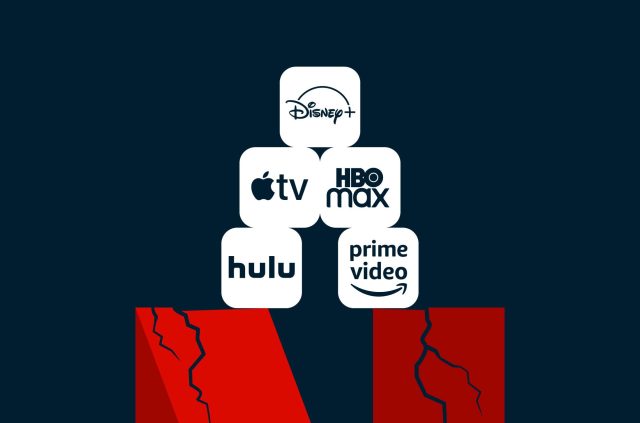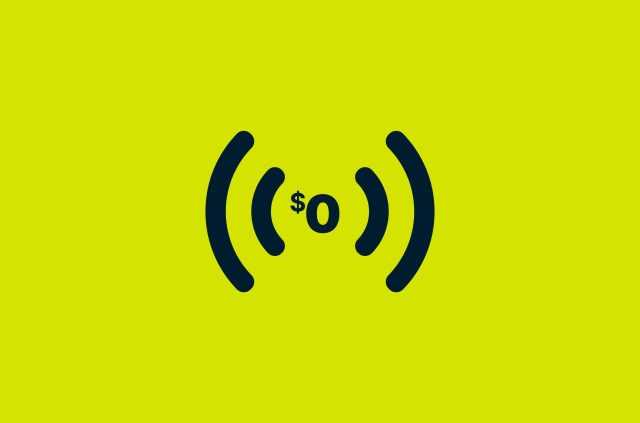Are you experiencing subscription fatigue? Here’s what you need to know

Subscriptions are everywhere now: from streaming services and meal kits to software tools and household essentials. At their best, they deliver convenience, flexibility, and real value. But when people feel overloaded or when companies make subscriptions difficult to manage, that’s when subscription fatigue sets in.
In this guide, we’ll explain what subscription fatigue means, how it’s shaping customer expectations, and why it’s become such a big talking point. We’ll also look at how subscription-based companies can reduce frustration, build trust, and keep customers engaged for the long term.
What does subscription fatigue mean?
Subscription fatigue is when people feel overwhelmed by the number of services they’re subscribed to, or when the value of those services isn’t clear. It’s common in media and entertainment, where streaming platforms keep multiplying, but it also happens in fast-moving consumer goods, like snacks, toiletries, and cleaning products), software, and other industries.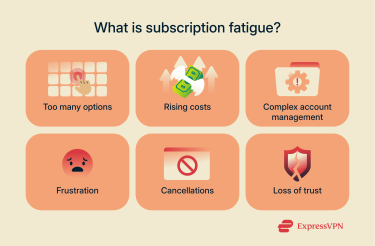 This feeling tends to grow as recurring charges pile up and people find themselves juggling too many accounts. Sooner or later, many start wondering if they’re really getting their money’s worth from each service. And when that doubt sets in, it can lead to cancellations and lower trust in subscription brands, especially those that don’t communicate their value well.
This feeling tends to grow as recurring charges pile up and people find themselves juggling too many accounts. Sooner or later, many start wondering if they’re really getting their money’s worth from each service. And when that doubt sets in, it can lead to cancellations and lower trust in subscription brands, especially those that don’t communicate their value well.
But it’s worth noting: subscription fatigue doesn’t mean subscriptions themselves are a problem. When done right, with clear pricing, flexible options, and genuine value, subscriptions remain one of the most convenient ways to access the products and services you want.
Subscription fatigue by the numbers
Subscription services keep growing, with the global market expected to reach nearly $1 trillion by 2028. But growth also means tougher choices for consumers: half say they’ve canceled or plan to cancel at least one service. In streaming, more than 60% of users feel overwhelmed by the number of platforms.
This doesn’t mean people are done with subscriptions; it means expectations are higher. Customers are looking for services that prove their value consistently and are easy to manage.
How much does an average person spend on subscriptions?
For many households, subscriptions take a bigger share of the budget than they realize. In streaming alone, the average monthly spend rose from $48 in 2023 to $61 in 2024, a 30% jump in just a year. Millennials spend even more, averaging $67 per month on streaming services, and that’s just one category.
When you factor in music, gaming, and product deliveries, the totals add up quickly. That’s why clarity, bundling, and visible value are so important. Customers don’t mind paying when they feel the benefit outweighs the cost.
Subscription sharing: Helpful or harmful?
Sharing subscriptions can be a good way to cut costs, and many platforms make this possible through family or household plans. These options give customers flexibility while helping companies protect their revenue.
- Netflix: A Netflix account is intended for people living in the same household. If someone outside your home wants access, they’ll need their own account, or, in many countries, you can pay for an extra member slot to include them on yours.
- Spotify: A Spotify Premium account is for individual use, but you can share through Premium Duo (two people at the same address) or Premium Family (up to six people in the same household), with address verification required.
- Amazon Prime: The platform lets you share most benefits through Amazon Family (formerly Amazon Household). You can include one additional adult, along with up to four children, as long as everyone shares the same primary residential address.
- Apple: Up to six family members in the same household can share Apple subscriptions (including Apple Music, TV+, Arcade, iCloud+, and Apple One bundles) through Family Sharing.
Informal password sharing beyond these rules can sometimes cause issues like account limits or security concerns. A Zebra survey found that 79% of users have given their password to someone outside their household, which can lead to account bans, unwanted charges, or security problems.
Learn more: Read about 6 easy ways to improve your online privacy and security.
Which countries spend the most on digital subscriptions?
The spending on digital subscriptions is heavily concentrated in a few key markets. According to UBS’s “Investing in Digital Subscriptions” report (you can download it from this page), here’s the breakdown:
- The United States commands about 53% of the global digital subscription market.
- Europe follows with around 21%, and China holds approximately 14%.
- Altogether, these three regions account for nearly nine out of every ten subscriptions purchased worldwide (88%).
This highlights how dominant these markets are in the global subscription economy. Most consumer spending is clustered there, with other regions contributing much less in comparison.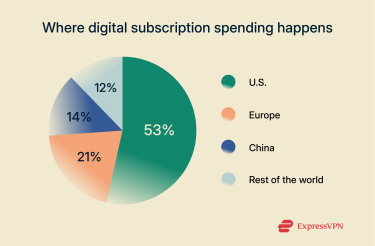
Why are we feeling overwhelmed by subscriptions?
Managing several subscriptions at once can quickly start to feel like a juggling act. Many people sign up during free trials or special offers and then lose track when prices go up.
Over time, those recurring charges add up, and each service comes with its own renewal dates, payment methods, and rules. What begins as a source of convenience can turn into extra admin work if it’s not well managed.
It’s this mix of rising costs and the effort of staying on top of multiple accounts that leaves some people feeling stretched, even though the goal of subscriptions is to make life easier.
Why do some subscription services make it difficult to cancel?
Canceling a subscription should be as straightforward as signing up. When companies make account management easy (whether that means pausing, switching, or ending a plan), it helps customers feel more in control and more likely to return in the future.
Friction in cancellation design
Some services make account changes harder than they need to be, such as requiring too many steps to cancel or presenting unclear options. While these tactics may slow cancellations in the short term, they often frustrate users and can erode long-term trust.
Lack of transparency in billing cycles
When subscription terms aren’t clearly explained, customers can be caught off guard by hidden fees or unexpected charges. Some companies bury important details in fine print or hide them behind small icons.
In 2024, the Federal Trade Commission (FTC) filed a complaint against Adobe over its “Annual, Paid Monthly” plan. The agency alleges that Adobe failed to clearly disclose the plan’s year-long commitment and a hidden early termination fee, and that canceling required navigating a lengthy, multi-step online process.
The FTC’s case underlines the importance of clear terms and straightforward cancellation flows, which help customers feel more confident in managing their subscriptions. But growing regulatory attention is a positive sign. It suggests these kinds of tricky practices are becoming less acceptable and will likely become less common in the future.
Perceived lock-in and FOMO tactics
Some platforms bundle multiple features or benefits into a single plan, which can make customers feel that canceling means giving up more than they actually use. This perceived loss can be amplified by last-minute prompts highlighting what they might miss, such as exclusive offers or saved time, a tactic linked to the fear of missing out (FOMO), which the Tooltester report found in nearly half (47.5%) of analyzed cancellation flows.
When paired with complex navigation, these reminders can add friction to the process. By contrast, services that present options clearly and make account changes straightforward tend to foster more trust and a better overall experience.
How to manage and reduce subscription fatigue
Feeling worn out by too many subscriptions doesn’t have to be permanent. With a few simple habits, you can regain control over your services, cut costs, and focus only on the ones that truly add value. 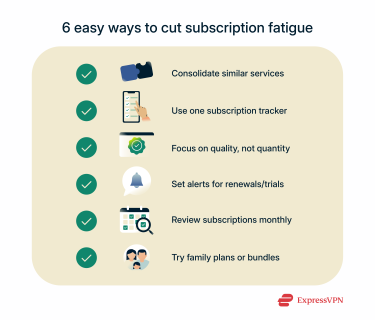
- Consolidate your services: If you’re paying for multiple platforms that offer similar features, consider dropping the ones you use less often. Keeping only the most relevant services will make them easier to manage and help prevent subscription overload and streaming fatigue while reducing unnecessary costs.
- Use a unified subscription tracker: A dedicated tracker or management tool can help you see all your subscriptions, billing dates, and charges in one place. This removes the need to remember each platform’s separate system and reduces the chance of missed cancellations.
- Prioritize quality over quantity: Having fewer subscriptions that deliver real value is often more satisfying than juggling many that you barely use. Focus on services that consistently meet your needs or provide something unique you can’t get elsewhere.
- Set alerts for renewals and trials: Mark trial end dates and renewal cycles in your calendar or phone reminders.
- Reassess subscription value monthly: Take a moment each month to review how much you’re using each service. If something hasn’t been worth the cost lately, it might be time to cancel or downgrade.
- Take advantage of family plans and bundles: Where possible, opt for family or group plans that allow multiple users under one subscription. Bundles can also combine several services at a reduced rate, lowering your overall spending and reducing digital burnout from managing too many accounts.
What subscription-based businesses can do to help
Subscription businesses have the ability to make the experience smoother for their customers and help prevent subscription overload or digital burnout. Small changes in how services are offered, billed, and managed can ease frustration, reduce the feeling of being overwhelmed by subscriptions, and encourage people to stay subscribed longer:
- Offer flexible plans and easier cancellations: Giving customers the option to pause, downgrade, or switch plans without penalties helps them feel more in control. If they can cancel subscriptions easily, it prevents negative experiences that could push them away for good.
- Be transparent with pricing and renewals: Being upfront about how much the service costs and when it will renew avoids unpleasant surprises and builds trust. Clear pricing and billing dates reduce misunderstandings and unnecessary cancellations.
- Deliver consistent value and personalization: When a service continues to deliver value and adapts to customer needs, there’s less reason to cancel. Listening to feedback, personalizing the experience, and providing something genuinely useful keeps the relationship strong.
- Design user-friendly UX patterns: Some platforms add unnecessary steps to cancel, push upgrades, or hide key information. This may delay cancellations briefly but often frustrates users. Clear, simple design instead builds trust and helps customers feel in control.
Learn more: Read how sites can get you to buy more.
FAQ: Common questions about subscription fatigue
What is subscription overload?
Subscription overload happens when people face too many subscriptions across different services and industries, making it harder to choose and keep track of what they have.
Why do I keep subscribing and forgetting?
People often keep subscribing and then forget about it because subscriptions are designed to be “set it and forget it.” The recurring payments happen automatically, and many services make signing up effortless but canceling less obvious.
Take the first step to protect yourself online. Try ExpressVPN risk-free.
Get ExpressVPN



